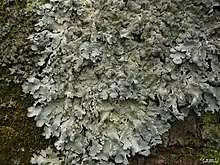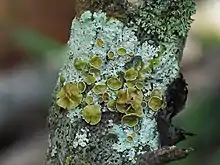Myelochroa
Myelochroa is a genus of foliose lichens in the family Parmeliaceae. They are commonly known as axil-bristle lichens. It was created in 1987 to contain species formerly placed in genus Parmelina that had a yellow-orange medulla due to the presence of secalonic acids. Characteristics of the genus include tightly attached thalli with narrow lobes, cilia on the axils, and a rhizinate black lower surface. Chemical characteristics are the production of zeorin and related triterpenoids in the medulla. Myelochroa contains about 30 species, most of which grow on bark. The genus has centres of distribution in Asia and North America.
| Myelochroa | |
|---|---|
 | |
| The powdery axil-bristle lichen, Myelochroa aurulenta | |
| Scientific classification | |
| Kingdom: | Fungi |
| Division: | Ascomycota |
| Class: | Lecanoromycetes |
| Order: | Lecanorales |
| Family: | Parmeliaceae |
| Genus: | Myelochroa (Asahina) Elix & Hale (1987) |
| Type species | |
| Myelochroa aurulenta (Tuck.) Elix & Hale (1987) | |
| Synonyms | |
| |
Taxonomy
Myelochroa was originally circumscribed by Yasuhiko Asahina as a subsection of section Hypotrachyna in genus Parmelia.[1] This taxon was later raised to sectional status by Hale in 1976.[2] It was promoted to generic status in 1987 by John Elix and Mason Hale. Nineteen species were originally placed in Myelochroa, including the type species, M. aurulenta.[3]
Myelochroa species are commonly known as "axil-bristle lichens".[4]
Description
Myelochroa lichens are small- to medium-sized foliose lichens. Their thalli comprises somewhat linear to irregularly shaped lobes. The lobes have simple (unbranched), slender, black cilia on the margin, sparsely or densely distributed. These are sometimes confined to lobe axils, other times they are more evenly distributed. The upper surface of the thallus is grey, or blue-grey, sometimes with a yellow tinge; this yellowish colour, if present, is more likely to be under the apothecia or close to the algal layer. The medulla is yellow-orange. The lower thallus surface is black and covered with mostly unbranched rhizines. The apothecia are lecanorine, with a reddish-brown cup that lacks perforations. The ascospores, which number eight per ascus, are simple, ellipsoid, colourless, and measure 5–8 by 8–14 μm.[3][4]
The upper cortex contains the lichen acids atranorin, chloroatranorin, and secalonic acid. The medulla contains hopane triterpene compounds such as zeorin and leucotylic acid as well as secalonic acid A. The presence of these triterpenes distinguishes this genus from Parmelina, and its segregate genera, including Parmelinella, and Parmelinopsis.[3] secalonic acid A is a yellow pigment that reacts C+ yellow and K+ yellow with lichen spot tests.[4]
Habitat and distribution
Most Myelochroa lichens are corticolous. They are largely found in temperate locations, with centre of distribution in eastern Asia and eastern North America. Twelve species of Myelochroa are found in South Korea.[5] The type species, Myelochroa aurulenta, is found throughout the world in temperate forests.[3]
Species
.jpg.webp)

- Myelochroa amagiensis (Asahina) Elix & Hale (1987)
- Myelochroa aurulenta (Tuck.) Elix & Hale (1987) – widespread
- Myelochroa coreana Y.S.Park (1990)[6] – South Korea; Malaysia
- Myelochroa crassata (Hale) Elix & Hale (1987)
- Myelochroa crenulata (J.C.Wei) Hale ex DePriest & B.W.Hale (1998)[7]
- Myelochroa degelii (Hale) Elix & Hale (1987)
- Myelochroa denegans (Nyl.) Elix & Hale (1987) – Asia; Australia
- Myelochroa entotheiochroa (Hue) Elix & Hale (1987) – Asia
- Myelochroa galbina (Ach.) Elix & Hale (1987) – Asia; North America
- Myelochroa hayachinensis (Kurok.) Elix & Hale (1987) – Jeju Island
- Myelochroa ibukiensis K.H.Moon, Kashiw. & Keis. Kobay. (2013)[8] – Japan
- Myelochroa immiscens (Nyl.) Elix & Hale (1987)
- Myelochroa indica (Hale) Elix & Hale (1987) – India
- Myelochroa irrugans (Nyl.) Elix & Hale (1987) – Asia
- Myelochroa leucotyliza (Nyl.) Elix & Hale (1987) – Asia
- Myelochroa lindmanii (Lynge) Elix & Hale (1987)
- Myelochroa macrogalbinica Divakar, Upreti & Elix (2001)[9] – India
- Myelochroa metarevoluta (Asahina) Elix & Hale (1987) – Asia; USA
- Myelochroa nothofagi Elix (1996)[10]
- Myelochroa obsessa (Ach.) Elix & Hale (1987)
- Myelochroa perisidians (Nyl.) Elix & Hale (1987) – Asia
- Myelochroa radiculata (Kurok.) Divakar & A.Crespo (2010)[11]
- Myelochroa rhytidodes (Hale) Elix & Hale (1987)
- Myelochroa salazinica Sheng L.Wang, J.B.Chen & Elix (2001)[12] – China
- Myelochroa sayanensis Otnyukova, Stepanov & Elix (2009)[13] – Siberia
- Myelochroa siamea Kurok. (1998)[14] – Thailand
- Myelochroa sibirica Otnyukova, Stepanov & Elix (2009)[13] – Siberia
- Myelochroa sikkimensis Divakar, Upreti, G.P.Sinha & Elix (2001)[9] – India
- Myelochroa sinica Sheng L.Wang, J.B.Chen & Elix (2001)[12] – China
- Myelochroa subaurulenta (Nyl.) Elix & Hale (1987)
- Myelochroa supraflava Canêz & Marcelli (2008)[15] – Brazil
- Myelochroa upretii Divakar & Elix (2001)[9] – India
- Myelochroa xantholepis (Mont. & Bosch) Elix & Hale (1987) – Asia
References
- Asahina, Yasuhiko (1952). Lichens of Japan, II: Genus Parmelia. Tokyo: Research Institute for Natural Resources. p. 74.
- Hale, Jr., Mason E. (1976). "A Monograph of the Lichen Genus Pseudoparmelia Lynge (Parmeliaceae)". Smithsonian Contributions to Botany. 33: 15.
- Elix, John A.; Hale, Mason E. (1987). "Canomaculina, Myelochroa, Parmelinella, Parmelinopsis and Parmotremopsis, five new genera in the Parmeliaceae (lichenized Ascomycotina)". Mycotaxon. 29: 233–244.
- Brodo, Irwin M.; Sharnoff, Sylvia Duran; Sharnoff, Stephen (2001). Lichens of North America. Yale University Press. p. 447. ISBN 978-0300082494.
- Jayalal, Udeni; Joshi, Santosh; Oh, Soon-Ok; Koh, Young Jin; Hur, Jae-Seoun (2018). "A taxonomic study of the genus Myelochroa in South Korea". Mycobiology. 40 (4): 217–224. doi:10.5941/MYCO.2012.40.4.217. PMC 3538967. PMID 23323045.

- Park; Yun Sil (1990). "The macrolichen flora of South Korea". The Bryologist. 93 (2): 105–160. doi:10.2307/3243619. JSTOR 3243619.
- DePriest, Paula T.; Hale, Beatrice Wilde (1998). "New combinations in parmelioid genera (Ascomycotina: Parmeliaceae)". Mycotaxon. 67: 201–206.
- Moon, K.H; Kashiwadani, H; Kobayashi, K. (2013). "A new species of Myelochroa (Parmeliaceae, Lecanorales) from Shiga Prefecture, Central Japan". Journal of Japanese Botany. 88: 140–143.
- Divakar, P.K.; Upreti, D.K.; Elix, John A. (2001). "New species and new records in the lichen family Parmeliaceae (Ascomycotina) from India". Mycotaxon. 80: 355–362.
- Elix, John A. (1996). "New species in the lichen family Parmeliaceae (Ascomycotina) from Australasia and Oceania". Mycotaxon. 59: 407–417.
- Crespo, Ana; Kauff, Frank; Divakar, Pradeep K.; del Prado, Ruth; Pérez-Ortega, Sergio; de Paz, Guillermo Amo; et al. (2010). "Phylogenetic generic classification of parmelioid lichens (Parmeliaceae, Ascomycota) based on molecular, morphological and chemical evidence". Taxon. 59 (6): 1735–1753. doi:10.1002/tax.596008.
- Wang, Sheng-Lan; Chen, Jian Bin; Elix, John A. (2001). "Two new species of the lichen genus Myelochroa (Parmeliaceae, Ascomycota) from China". Mycotaxon. 77: 25–30.
- Otnyukova, Tatyana N.; Stepanov, Nikolay V.; Elix, John A. (2009). "Three new species of Parmeliaceae (Ascomycota) from Siberia". Mycotaxon. 108 (1): 249–256. doi:10.5248/108.249.
- Kurokawa, S. (1998). "A new record and a new species in Myelochroa (Parmeliaceae)" (PDF). Journal of Japanese Botany. 73 (1): 12–14.
- Marcelli, Marcelo P.; Canêz, Luciana S. (2008). "Novelties on Southern Brazilian Parmeliaceae". Mycotaxon. 105: 225–234.